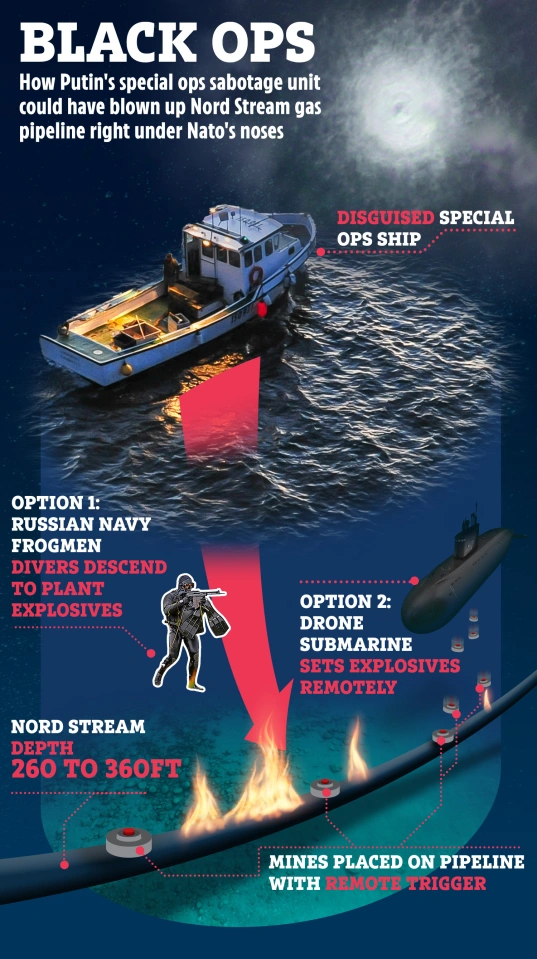The Deep Dive’s Sunday feature: “Sabotage!? The Nord Stream Russian Bubble Theory” really blew up on us. Even now, various voices in the comments thread are adding context and counterpoint to The Russian Bubble Theory from various points of experience greater than ours, making it apparent that bloggers are not qualified to be experts on undersea pipelines. But we aren’t going to let that stop us.
The Dive maintains that our (apparently unique) contribution to this information vacuum is entirely reasonable and responsible. Accidental pipeline explosions, historically, are much more common than intentional acts of sabotage, and ought to be considered a possibility. Anyone who thinks our imaginations have run away with us really ought to have a look at what’s coming out of The Sun.

Frogman has his gun out under water, so you know it’s dangerous down there. Watch out, Frogman!
The Rupert Murdoch property has its art department working overtime, drawing up ways that the Russians could have used frogmen to blow up their own pipeline, or the Russians could have used submarines to blow up their own pipeline, ignoring the whole way along that the Russians have full and unrestricted access to the inside of that pipeline.
If Russia was at all interested in turning a cash generating asset, that it built itself at considerable expense, into garbage on the sea floor, it would be much easier and less trouble to rig a pigging device with plastic explosives, send it down the line until it’s right where they want it, and hit the button. Why? We can’t tell, but suggest asking The Sun, who has drawn a whole comic strip about all the other, less plausible ways they might go about it.

Surely, Gazprom has every reason to be upset with the German government, which effectively stole their European landing and distribution network, but scuttling the pipe seems like an extreme (and self-defeating) response. It’s much easier just to refuse to ship gas.
And that’s exactly what it was doing. Nord Stream 1 developed technical problems shortly after the Germans took control of the receiving end, in what seems like an obvious and predictable power move. “You might be able to set the terms on your side of the pipe; but we set the terms on our side. And our side is the side with the gas.”
Get it Together…
The Dive is quite happy to concede that our theory about Gazprom adding air to the pipe in response to German theft is pure speculation, and hope our readers understand that it’s meant to be an illustration of the type of thing that might happen, given the larger and more important prevailing circumstances: The opposite ends of this pipe were owned and controlled by different parties on opposite ends of a hostile relationship.
The German nationalization of Gazprom Germania (now SEFE) and the Russian scaling back of supply didn’t happen underwater with nobody watching. Neither did the bankruptcy of Nord Stream AG which, presumably, was responsible for the pipe’s upkeep and maintenance.
It’s just as likely that Russia wasn’t about to leave gas sitting in a pipe that goes to someone who doesn’t want to buy it, so they started depressurizing it from their end, and Germany, worried about potential damage to the pipe from depressurization, started adding air from its end. It isn’t like they were in a position to backload it with gas.
Nord Stream 1 and 2 were meant to be the middle parts of an orchestrated, ongoing gas transaction, operated by cooperating parties. Without the transaction, there’s no longer a reason to cooperate. And without cooperation, there is no orchestration, and the order meant to keep the pipes full of moving, pressurized gas quickly becomes chaos.
Chaos doesn’t keep anything. Chaos returns things to their natural states.










4 Responses
Simple, apparently unanswered question.
Was the damage from an internal or external explosion?
I think it’s the right question, but don’t know the extent to which it can be determined on a post-explosion sea floor. It probably just looks like it’s been blown to smithereens, then whipped around by the ocean.
Certainly, if it’s determined that the leaks on both lines were the result of explosions, as opposed to one of them being caused by debris & disturbance from the explosion next door, sabotage starts to look more likely.
Thanks for reading.
Braden, here’s a “what if” for you. Your car tires get low in pressure so you add air, they get high so you let it out. It’s a gas law thing at constant volume with a change in temperature.
What about a pipe locked up with gas? Well you tie it to a pressure regulator from a high source pressure and set it to the pipe pressure. Do they have a high pressure gas accumulators on the Russian side? Or was compressor down? Was it tied to compressed dry air?
Would the temperature gradients through the pipe provide good mixing?
If I needed gas, could I sneak it through the regulator by pulling on it from my end? Could be a bad if I had been pulling in dry air.
You might be on to something.
Now the Swedes are saying evidence of a detonation. Well, yeah of course what else. Show us the photos already, will ya?
These are great questions.
The devil is always in the details, and the equipment at the feed and draw ends, and how that equipment was configured, matters here. A more enterprising researcher might be able to find the specs for the setups on each end, but one imagines that they’re in some state of flux, given that they’re shipping gas, then not shipping gas on line 1, and were at high pressure & not shipping at line 2. The Russians deciding they’re going to bleed some out with the pressure that’s in there, for example, would probably take an equipment change, but that shouldn’t be a problem; it’s the world’s largest gas company. Surely they can fit it, and re-fit it however they want.
Presumably, the undersea portion of the pipe has a fairly consistent temperature; it isn’t like an on-land pipe that goes through various states of sun and shade throughout the day. But I don’t know about how cold affects gas mixes.
Thanks again for reading!